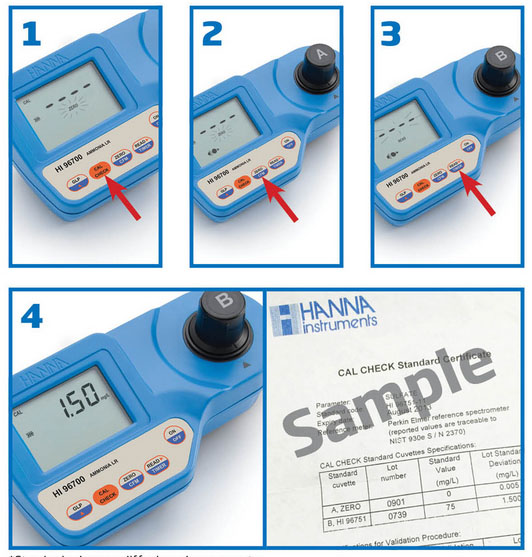Combines accuracy and ease of use in an ergonomic, portable design, the photometer allows the user to accurately determine the pH, free chlorine, and total chlorine concentration of water samples using ready-made reagents. Features a CAL Check™ function used for performance verification and calibration of the meter.
Combines accuracy and ease of use in an ergonomic, portable design, the photometer allows the user to accurately determine the pH, free chlorine, and total chlorine concentration of water samples using ready-made reagents. Features a CAL Check™ function used for performance verification and calibration of the meter.
Discontinued!
This product has been discontinued and is no longer available.
This is the direct replacement:
The portable photometer is for the measurement of pH, free chlorine, and total chlorine, and features an advanced optical system; the combination of a special tungsten lamp, a narrow band interference filter, and silicon photodetector ensure accurate photometric readings every time. The cuvette locking system ensures that the cuvette is inserted into the measurement cell in the same position every time to maintain a consistent path length.
Features
Significance of use

Three critical parameters that can be tested to ensure good water quality are pH, free chlorine, and total chlorine. Chlorine is one of the most commonly used disinfectants for drinking water, wastewater, and water used for pools and spas. It can be added to in various forms including calcium hypochlorite, sodium hypochlorite, or in some instances, chlorine gas. When added to water, chlorine creates hypochlorous acid (HOCl) which dissociates into hypochlorite ion (OCl).
HOCl ↔ H+ + OCl
hypochlorous acid ↔ hydrogen ion + hypochlorite ion
HOCl is the form of chlorine that acts as a stronger disinfectant as compared to OCl. To ensure the added chlorine is effective at sanitizing, the pH of the water must be taken into account. Around pH 7.5, HOCl and OCl are present in relatively equal amounts. Below pH 7.5, the equilibrium shifts to favor HOCl; above pH 7.5, the equilibrium shifts to favor OCl. Depending on the application, addition of chlorine is effective when added to water with a neutral or slightly acidic pH value.
When chlorine is first added to water, it is available as free chlorine. The measurement of free chlorine signifies the amount available for disinfection. Once chlorine begins to sanitize bacteria and pathogens present in the water, it becomes combined chlorine; combined chlorine is no longer available to act as a disinfectant. The measurement of total chlorine signifies the amount of free chlorine and combined chlorine. With both free and total chlorine measurements, a drinking water operator or pool owner can determine if there is enough chlorine available for disinfection.
The photometer offers multiple methods within one meter. pH determination uses the phenol red method while free and total chlorine determination uses an adaptation of the EPA method 330.5 and Standard Method 4500-Cl G. The reagents are in powder and liquid form depending on the parameter being tested.
When the appropriate reagent is added to the sample, it will display a color change; the greater the concentration, the deeper the color. The associated color change is then colorimetrically analyzed according to the Beer-Lambert Law. This principle states that light is absorbed by a complementary color, and the emitted radiation is dependent upon concentration. For determination of pH and free and total chlorine, a narrow band interference filter at 525 nm (green) allows only green light to be detected by the silicon photodetector and omits all other visible light emitted from the tungsten lamp. As the change in color of the reacted sample increases, absorbance of the specific wavelength of light also increases, while transmittance decreases.
Simple to use

| pH (P1) | |
| Range | 6.5 to 8.5 pH |
| Resolution | 0.1 pH |
| Accuracy at 77°F (25°C) | ±0.1 pH |
| Chlorine, Free (P2) | |
| Range | 0.00 to 5.00 mg/L (ppm) |
| Resolution | 0.01 mg/L under 3.50 mg/L 0.10 mg/L above 3.50 mg/L |
| Accuracy at 77°F (25°C) | ±0.03 mg/L ±3% of reading |
| General Specifications | |
| Light Source | Tungsten lamp |
| Light Detector | Silicon photocell with narrow band interference filter @ 525 nm |
| Power Supply | 9 V battery |
| Auto-Off | After ten minutes of non-use in measurement mode; after one hour of non-use in calibration mode; with last reading reminder |
| Environment | 32 to 122°F (0 to 50°C); RH max 95% non-condensing |
| Dimensions | 7.6 x 4.1 x 2.7" (192 x 104 x 69 mm) |
| Weight | 11.3 oz (320 g) |
| Methods | pH: phenol red method Chlorine: adaptation of the EPA recommended DPD method |
| pH (P1) | |
| Range | 6.5 to 8.5 pH |
| Resolution | 0.1 pH |
| Accuracy at 77°F (25°C) | ±0.1 pH |
| Chlorine, Free (P2) | |
| Range | 0.00 to 5.00 mg/L (ppm) |
| Resolution | 0.01 mg/L under 3.50 mg/L 0.10 mg/L above 3.50 mg/L |
| Accuracy at 77°F (25°C) | ±0.03 mg/L ±3% of reading |
| General Specifications | |
| Light Source | Tungsten lamp |
| Light Detector | Silicon photocell with narrow band interference filter @ 525 nm |
| Power Supply | 9 V battery |
| Auto-Off | After ten minutes of non-use in measurement mode; after one hour of non-use in calibration mode; with last reading reminder |
| Environment | 32 to 122°F (0 to 50°C); RH max 95% non-condensing |
| Dimensions | 7.6 x 4.1 x 2.7" (192 x 104 x 69 mm) |
| Weight | 11.3 oz (320 g) |
| Methods | pH: phenol red method Chlorine: adaptation of the EPA recommended DPD method |